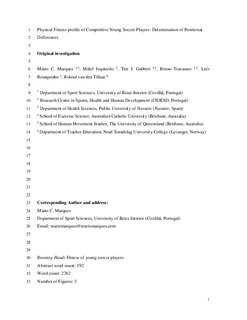Physical fitness profile of competitive young soccer players : Determination of positional differences
Marques, Mario C.; Izquierdo, M; Gabbett, Tim J.; Travassos, B; Branquinho, L; van den Tillaar, Roland Johannes Wilhelmus
Journal article, Peer reviewed
Permanent lenke
http://hdl.handle.net/11250/2433402Utgivelsesdato
2016Metadata
Vis full innførselSamlinger
Originalversjon
Marques, M.C., Izquierdo, M., Gabbett, T.J., Travassos, B., Branquinho, L. & van den Tillaar, R.J.W. (2016). Physical fitness profile of competitive young soccer players: Determination of positional differences. International Journal of Sports Science and Coaching, 11(5), 693-701. doi: 10.1177/1747954116667107Sammendrag
The aim of this study was to compare the anthropometric and physical fitness characteristics of the different playing positions in adolescent soccer players. Furthermore, differences among playing ages (under 14, under 16, and under 18 years) were determined. One hundred and sixty-seven young male national level soccer players were tested on anthropometric characteristics and physical performance tests (30 m sprint, ball kicking, overhead medicine ball throw, and countermovement jump). The results demonstrated differences in anthropometric characteristics between positions (p less than 0.05). Differences were also found in the physical performance tests; forwards performed better in the throwing, countermovement jump, and sprint tests than defenders. Midfielders demonstrated greater countermovement jump performances than right defenders. Our results highlight that there is an influence of playing position on the anthropometric and physical qualities in adolescent players. This emphasizes the importance of evaluating the physical profile of players and their development according to playing age and playing position.
Beskrivelse
Author's accepted version (post-print).
